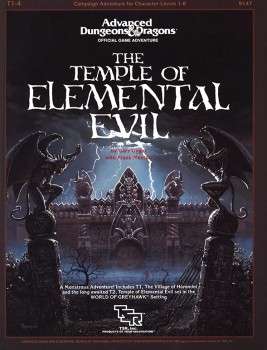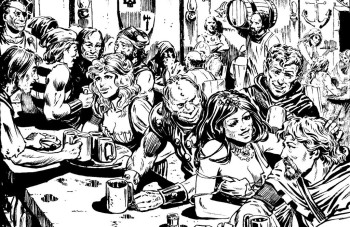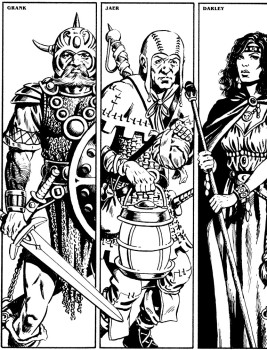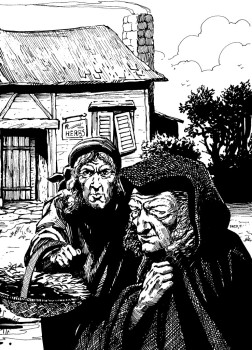Art of the Genre: The Artistic Mystery of The Temple of Elemental Evil and the Turmoil of 1985 TSR

Back in 1985 I was fourteen and had recently entered the gaming hobby as a hardcore fan and not a passing-fancy type player. It was during my plunge into the hobby that I began grabbing up whatever I could get on my monthly trips to the ‘big city’ of Lafayette, Indiana. During one of these outings with my mother, who would entice me to go to the Mall or any other boring errands she had by offering to also take me downtown to Main Street Hobbies, that I acquired T1-4, The Temple of Elemental Evil.
It was my first ‘super-module’, and although I’d missed the chance to get most of the original-run TSR modules from 1979-82, I was thrilled to grab this new breed module by Gary Gygax and Frank Mentzer. Little did I realize at the time what it took to actually produce this module. I mean, by 1985 Gary was already on the chopping block at TSR and the company was ready to undergo a massive changeover that would result in AD&D 2E, and the ‘downfall’ of the company as we knew it. Times, as they say, were a’changin.
Now I can’t speak for the inner workings of how this module was made, but it is well documented that Gygax himself began work on T2: The Temple of Elemental Evil after he’d completed T1: The Village of Hommlet in 1979. However, probably due to the company’s rapid expansion and then his departure to Hollywood to work on the Dungeons & Dragons cartoon, his work was never completed by his own hand. Enter Frank Mentzer, who completed the module, and finally allowed it to see the light of day six years after players had been introduced to the story line in T1.
When I purchased it, I wasn’t ready to run such a complex dungeon crawl, and so I turned the module over to my friend Mark, who ran me through it over the course of our summer vacation. I well remember running four characters in the adventure, and I’m sure Mark had the same number of NPCs, the bulk of it played on the floor of the downstairs living room at my mother’s house.
It wasn’t until 1988 that I actually ran the module myself, this time with my friend Murph, who was helping me develop my own gaming sandbox of The Nameless Realms. It was another epic ‘run’, and afterward, I put the module away and have thought of it fondly ever since.

However, now that I hold it today, I’m reminded of the TSR drama going on in 1985. Now remember, TSR was already starting to implode financially by 1984, and with Gary’s return from Hollywood ‘exile’, and his subsequent ousting of the Blume ownership group, the company had to be in relative chaos.
Once the Blumes sold their controlling interest to Lorraine Williams, it put Gygax himself on the chopping block and he was forced out by the autumn of 1985.
So, all this drama was going on during the time of The Temple of Elemental Evil’s production, and as such, it’s a pretty big triumph for our hobby that it was produced at all. Still, the influence of the tectonic shifts of TSR is apparent in the module’s framework, both in writing, and of course the artwork.

Now having established that Mentzer (certainly no scrub writer) was brought in as a scab to finish this work, fans still aren’t necessarily given Gygax’s true vision, or at least that is the extrapolation I take on events. Perhaps this is evident in the writing, I can’t say for certain, but the upheaval is readily apparent in the artwork.
Although expertly covered by artist Keith Parkinson, the remainder of The Temple of Elemental Evil veritably screams that it was birthed in a maelstrom of financial panic and leadership void.
Now remember, a standard 32-page AD&D module from TSR in 1982 would contain between 15-20 original black & white illustrations. Thus, it could be surmised that a ‘super-module’, especially one with the pedigree of T1-4, and at 130 pages, should contain upwards of 80 pieces of artwork. Also taking into account that TSR employed the ‘Big Four’ (Easley, Elmore, Caldwell, and Parkinson) at the time, and you can well imagine what this should have looked like.

Instead, and most dishearteningly, T1-4 has only 21 illustrations, with 2 of those being Trampier works repurposed from T1, and another 1/8th page spot illustrations of small items. I mean, Part 3 doesn’t even have a single illustration!
Now, to top it all off, and give you yet another insight into this module’s failure to launch artistically, the bulk of the work inside is done by artist Jack Fred. What?!
Looking over the credits, we see the usual suspects of Jeff Butler (who did Zuggtmoy in the back), Trampier (who was repurposed from T1), Clyde Caldwell (who did a two page spread of 6 pre-gen characters, and probably the best art in the book), Larry Elmore (who did a single bar scene for the intro to the town of Nulb), and finally Jeff Easley (who did everything else).
But wait, who is Jack Fred, you ask? Well, so the story goes, when Larry Elmore was working at Ft. Knox, he would get art assignments that were rushed and instead of signing his name, he’d instead credit ‘Jack Fred’ so the artwork couldn’t be traced back to him. Thus, a rather peevish Jeff Easley, certainly under way too heavy a deadline on this one, ended up signing J. Fred, Jack F, and Jack Fred, to all of his pieces that contain his signature at all in the module.
So, not only do we have a super module finished by another writer, and one sorely lacking in overall art, but also so rushed that the primary artist himself refused to sign his work!
Thus, the ‘great’ mystery of T1-4 isn’t really why it is such an oddity, but probably that it was produced at all. Whatever the case, I’m saddened that Gygax’s renewed verve for his company, as well as vision for its future, couldn’t have been realized, along with his own finishing of The Temple of Elemental Evil, and certainly the artistic treatment I know he believed it deserved.
As always, thanks for reading AotG, and if you enjoy what I do, hopefully you can really help out with a pledge or share of my new OSR art inspired 5E module Kickstarter.
I recently read Designers and Dragons: The Eighties. As you mentioned, Gygax had come back from Hollywood and gotten Kevin Blume booted from the top spot (though not off the Board).
Gygax took several different actions related to financially saving the company in 1985. Included was cutting lines like Boot Hill and Star Frontiers. He reorganized the model for Dragon Magazine and wrote off some stock for accounting purposes.
But the visible impacts were related to generating new revenue. He published Unearthed Arcana, Oriental Adventures, the first Gord the Rogue novel, Lankhmar: City of Adventure, Temple of Elemental Evil and Isle of the Ape.
Gygax really had an amazing impact in 1985 and I think he viewed Temple as a high profile project that already had a head start (for quite a few years..), so it was pushed out along with all the other products.
Bob: I certainly agree with that. There is no doubt this module is both classic and important, and if I may say so myself, a fun adventure, but the artwork and additional writer do feel forced. That adds to the financial stress as well as the stress Gygax was under to not only save his company, but fend off attacks to take control from him. In the end, he failed on the first, and 14 years later TSR was no more.
By 1985 I was no longer gaming. So glad too. It seems now that the TSR line of products that I knew (1979-83) were the “glory days” of D&D.
James: In many cases, I’d agree with you. Post Gygax was tough, but I still enjoyed bits and pieces, namely Planescape, Spelljammer, and of course The Forgotten Realms. A decade later, by 1995, TSR was a wasteland in my book.
[…] Art of the Genre: The Artistic Mystery of The Temple of Elemental Evil and the Turmoil of 1985 TSR by Scott Taylor The Dungeons (and Dragons) of My Life, Part One by Jon Sprunk Four Modules by James Maliszewski io9 Looks at the Megadungeon Get The Temple of Elemental Evil for Free at DriveThruRPG The Seven Greyhawk Classics of the Ancient World A Return to The Village of Hommlet (4E Style) The Art of Storytelling and The Temple of Elemental Evil by Matthew David Surridge Black Gate Recommends… The Temple of Elemental Evil […]